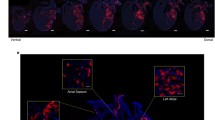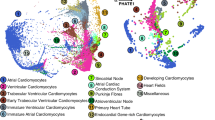Abstract
Adrenaline and noradrenaline are important neurotransmitter hormones that mediate physiological stress responses in adult mammals, and are essential for cardiovascular function during a critical period of embryonic/fetal development. In this study, we describe a novel mouse model system for identifying and characterizing adrenergic cells. Specifically, we generated a reporter mouse strain in which a nuclear-localized enhanced green fluorescent protein gene (nEGFP) was inserted into exon 1 of the gene encoding Phenylethanolamine n-methyltransferase (Pnmt), the enzyme responsible for production of adrenaline from noradrenaline. Our analysis demonstrates that this knock-in mutation effectively marks adrenergic cells in embryonic and adult mice. We see expression of nEGFP in Pnmt-expressing cells of the adrenal medulla in adult animals. We also note that nEGFP expression recapitulates the restricted expression of Pnmt in the embryonic heart. Finally, we show that nEGFP and Pnmt expressions are each induced in parallel during the in vitro differentiation of pluripotent mouse embryonic stem cells into beating cardiomyocytes. Thus, this new mouse genetic model should be useful for the identification and functional characterization of adrenergic cells in vitro and in vivo.








Similar content being viewed by others
References
Thomas, S. A., Matsumoto, A. M., & Palmiter, R. D. (1995). Noradrenaline is essential for mouse fetal development. Nature, 374, 643–646.
Zhou, Q. Y., Quaife, C. J., & Palmiter, R. D. (1995). Targeted disruption of the tyrosine hydroxylase gene reveals that catecholamines are required for mouse fetal development. Nature, 374, 640–643.
Kvetnansky, R., Sabban, E. L., & Palkovits, M. (2009). Catecholaminergic systems in stress: Structural and molecular genetic approaches. Physiological Reviews, 89, 535–606.
Bao, X., Lu, C. M., Liu, F., Gu, Y., Dalton, N. D., Zhu, B. Q., et al. (2007). Epinephrine is required for normal cardiovascular responses to stress in the phenylethanolamine N-methyltransferase knockout mouse. Circulation, 116, 1024–1031.
Ignarro, L. J., & Shideman, F. E. (1968). Appearance and concentrations of catecholamines and their biosynthesis in the embryonic and developing chick. Journal of Pharmacology and Experimental Therapeutics, 159, 38–48.
Ebert, S. N., Baden, J. M., Mathers, L. H., Siddall, B. J., & Wong, D. L. (1996). Expression of phenylethanolamine n-methyltransferase in the embryonic rat heart. Journal of Molecular and Cellular Cardiology, 28, 1653–1658.
Ebert, S. N., & Thompson, R. P. (2001). Embryonic epinephrine synthesis in the rat heart before innervation: Association with pacemaking and conduction tissue development. Circulation Research, 88, 117–124.
Ebert, S. N., Rong, Q., Boe, S., Thompson, R. P., Grinberg, A., & Pfeifer, K. (2004). Targeted insertion of the Cre-recombinase gene at the phenylethanolamine n-methyltransferase locus: A new model for studying the developmental distribution of adrenergic cells. Developmental Dynamics, 231, 849–858.
Bohn, M. C., Goldstein, M., & Black, I. B. (1982). Expression of phenylethanolamine N-methyltransferase in rat sympathetic ganglia and extra-adrenal chromaffin tissue. Developmental Biology, 89, 299–308.
Hammang, J. P., Bohn, M. C., & Messing, A. (1992). Phenylethanolamine N-methyltransferase (PNMT)-expressing horizontal cells in the rat retina: A study employing double-label immunohistochemistry. The Journal of Comparative Neurology, 316, 383–389.
Ziegler, M. G., Bao, X., Kennedy, B. P., Joyner, A., & Enns, R. (2002). Location, development, control, and function of extraadrenal phenylethanolamine N-methyltransferase. Annals of the New York Academy of Sciences, 971, 76–82.
Ziegler, M. G., Kennedy, B. P., & Houts, F. W. (1998). Extra-adrenal nonneuronal epinephrine and phenylethanolamine-N-methyltransferase. Advances in Pharmacology, 42, 843–846.
Davidoff, M. S., Ungefroren, H., Middendorff, R., Koeva, Y., Bakalska, M., Atanassova, N., et al. (2005). Catecholamine-synthesizing enzymes in the adult and prenatal human testis. Histochemistry and Cell Biology, 124, 313–323.
Pendleton, R. G., Gessner, G., & Sawyer, J. (1978). Studies on the distribution of phenylethanolamine N-methyltransferase and epinephrine in the rat. Research Communications in Chemical Pathology and Pharmacology, 21, 315–325.
Andreassi, J. L., Eggleston, W. B., & Stewart, J. K. (1998). Phenylethanolamine N-methyltransferase mRNA in rat spleen and thymus. Neuroscience Letters, 241, 75–78.
Andreassi, J. L., Eggleston, W. B., Fu, G., & Stewart, J. K. (1998). Phenylethanolamine N-methyltransferase mRNA in rat hypothalamus and cerebellum. Brain Research, 779, 289–291.
Bergquist, J., Tarkowski, A., Ekman, R., & Ewing, A. (1994). Discovery of endogenous catecholamines in lymphocytes and evidence for catecholamine regulation of lymphocyte function via an autocrine loop. Proceedings of the National Academy of Sciences of the United States of America, 91, 12912–12916.
Josefsson, E., Bergquist, J., Ekman, R., & Tarkowski, A. (1996). Catecholamines are synthesized by mouse lymphocytes and regulate function of these cells by induction of apoptosis. Immunology, 88, 140–146.
Ebert, S. N., Rong, Q., Boe, S., & Pfeifer, K. (2008). Catecholamine-synthesizing cells in the embryonic mouse heart. Annals of the New York Academy of Sciences, 1148, 317–324.
Farley, F. W., Soriano, P., Steffen, L. S., & Dymecki, S. M. (2000). Widespread recombinase expression using FLPeR (flipper) mice. Genesis, 28, 106–110.
Maltsev, V. A., Wobus, A. M., Rohwedel, J., Bader, M., & Hescheler, J. (1994). Cardiomyocytes differentiated in vitro from embryonic stem cells developmentally express cardiac-specific genes and ionic currents. Circulation Research, 75, 233–244.
Wobus, A. M., Wallukat, G., & Hescheler, J. (1991). Pluripotent mouse embryonic stem cells are able to differentiate into cardiomyocytes expressing chronotropic responses to adrenergic and cholinergic agents and Ca2+ channel blockers. Differentiation, 48, 173–182.
Van Overstraeten-Schlogel, N., Delgaudine, M., Beguin, Y., & Gothot, A. (2006). Limitations of the use of GFP transgenic mice in bone marrow transplantation studies. Leukaemia & Lymphoma, 47, 1392–1393.
Swenson, E. S., Price, J. G., Brazelton, T., & Krause, D. S. (2007). Limitations of green fluorescent protein as a cell lineage marker. Stem Cells, 25, 2593–2600.
Harper, C. V., Finkenstadt, B., Woodcock, D. J., Friedrichsen, S., Semprini, S., Ashall, L., et al. (2011). Dynamic analysis of stochastic transcription cycles. PLoS Biology, 9, e1000607.
Held, W., & Kunz, B. (1998). An allele-specific, stochastic gene expression process controls the expression of multiple Ly49 family genes and generates a diverse, MHC-specific NK cell receptor repertoire. European Journal of Immunology, 28, 2407–2416.
Acknowledgments
This study was supported by funding from the NIH (HL78716) to S.N.E., and intramural NICHD funds to K.P.
Author information
Authors and Affiliations
Corresponding author
Electronic Supplementary Material
Below is the link to the electronic supplementary material.
12033_2012_9570_MOESM1_ESM.tif
Supplemental Figure 1. Control Pnmt +/+ mouse adrenal gland sections. (A) nEGFP expression (green). (B) Anti-GFP IF staining (red). (C) DAPI nuclear stain (blue). (D) Overlay of images obtained in panels A-C. Scale bar, 30 μm. Only the medulla region of the adrenal section is shown for comparison with positive staining observed in Fig. 5. (TIFF 2599 kb)
12033_2012_9570_MOESM2_ESM.tif
Supplemental Figure 2. Fluorescence expression and staining in control undifferentiated mESCs. (A) nEGFP expression (green). (B) Anti-GFP IF staining (red). (C) DAPI nuclear stain (blue). (D) Overlay of images obtained in panels A-C. Scale bar, 10 μm. (TIFF 4653 kb)
12033_2012_9570_MOESM3_ESM.tif
Supplemental Figure 3. Fluorescence expression and staining in cardiac-differentiated (7 + 5d) mESCs. (A) nEGFP expression (green). (B) Anti-GFP IF staining (red). (C) DAPI nuclear stain (blue). (D) Overlay of images obtained in panels A-C. Scale bar, 10 μm. (TIFF 1607 kb)
Rights and permissions
About this article
Cite this article
Xia, J., Varudkar, N., Baker, C.N. et al. Targeting of the Enhanced Green Fluorescent Protein Reporter to Adrenergic Cells in Mice. Mol Biotechnol 54, 350–360 (2013). https://doi.org/10.1007/s12033-012-9570-3
Published:
Issue Date:
DOI: https://doi.org/10.1007/s12033-012-9570-3




